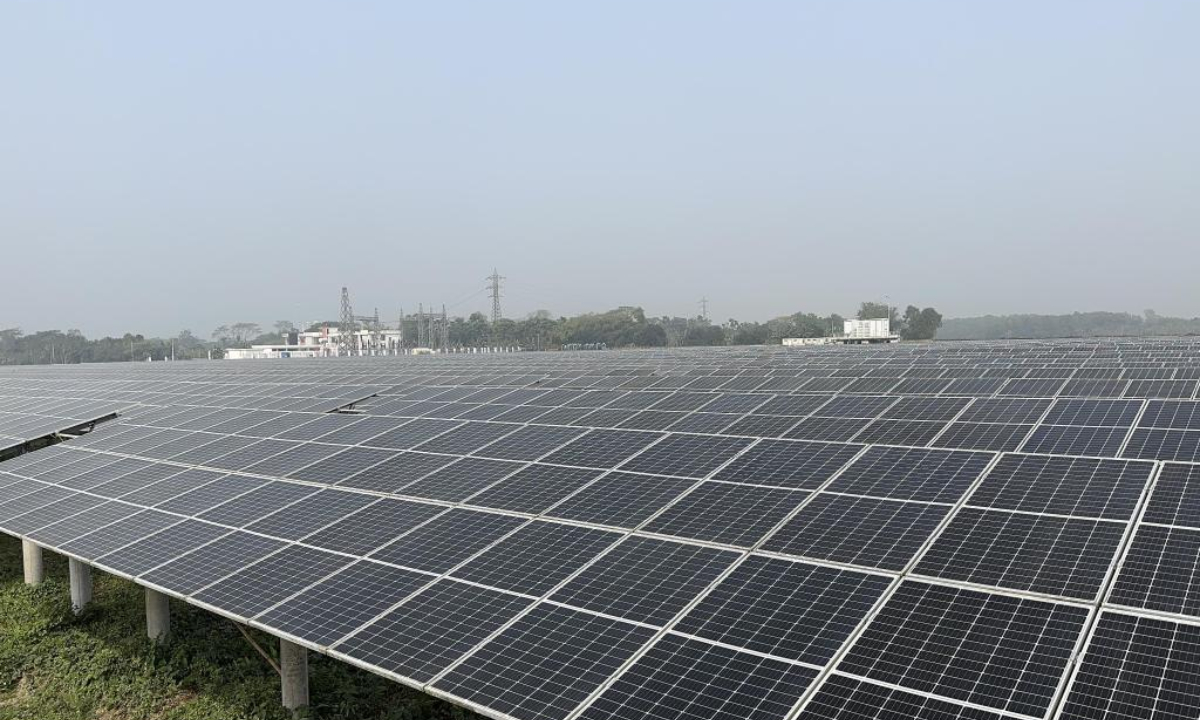
China’s Leadership in Green Industries and Sustainable Development


This photo taken on Feb. 17, 2024 shows a 50 MW Chinese-built photovoltaic power plant in Mymensingh District, Bangladesh. Photo:Xinhua

Photo: Courtesy of Vaqar Ahmed
Introduction
China has become a global leader in the production of green and new-energy products, achieving a significant milestone in its economic transformation. In 2023, China’s exports of new-energy vehicles (NEVs), solar cells, and lithium-ion battery products exceeded 1 trillion yuan (138 billion), positioning the country at the forefront of the green industry revolution. This growth not only demonstrates China’s commitment to sustainability but also presents opportunities for developing countries to accelerate their industrialization and contribute to the global energy transition.
Factors Driving China’s Green Industries
The expansion of China’s green industries is a result of strategic vision, innovation, government support, technological advancements, regional and global trade, and a conducive domestic business environment. China’s investment in research and development, along with its focus on scaling up production capacity, has enabled it to achieve economies of scale and reduce production costs. Additionally, China’s commitment to sustainable development goals has led to investments in renewable energy infrastructure, further fueling the growth of green industries.
Integrated Approach to Technology, Manufacturing, and Market Development
China’s success in forming competitiveness in emerging industries stems from its integrated approach to technology, manufacturing, and market development. Leveraging its vast manufacturing capabilities, skilled workforce, and extensive supply chain networks, China has rapidly scaled up production to meet the growing demand for green products both domestically and internationally. Proactive policies have stimulated market demand and encouraged innovation in green technologies.
Opportunities for Global Growth
The increasing demand for green industry and new-energy products during the energy transition presents growth opportunities for China and the global economy. As countries worldwide strive to reduce carbon emissions and transition to renewable energy sources, the demand for clean energy technologies is expected to soar. This trend is driven by environmental concerns, regulatory incentives, and technological advancements. Developing countries can capitalize on the growing green market and position themselves as leaders in sustainable development.
Potential Cooperation with Pakistan
China’s cooperation with other countries, particularly Pakistan, in the green and new-energy industries holds promise. Pakistan, like many developing countries, faces challenges in meeting its energy needs while addressing environmental concerns. By partnering with China, a global leader in green technology and manufacturing, Pakistan can access state-of-the-art solutions and expertise to accelerate its transition to clean energy. Collaboration in areas such as renewable energy infrastructure, electric vehicle deployment, and battery storage systems can enhance Pakistan’s energy security, drive economic growth, and create jobs.
China’s Global Contribution to Sustainable Development
China’s contribution to the global energy transition and sustainable development extends beyond its borders. By offering cost-effective green products to countries like Pakistan, China plays a pivotal role in promoting access to clean energy technologies and facilitating the adoption of sustainable practices worldwide. Initiatives such as the Belt and Road Initiative (BRI) support infrastructure development and capacity-building efforts in partner countries, promoting green growth and environmental sustainability on a global scale.
Addressing Criticisms and Strengthening Multilateral Trade
Despite commendable efforts, China faces protectionism and accusations of “overcapacity” in the international arena. Critics argue that China’s rapid expansion of green manufacturing capacity has led to oversupply in certain markets, undermining domestic industries in other countries. However, it is important to recognize the broader benefits of China’s green capacity, including job creation, technological innovation, and environmental protection. Addressing global challenges like climate change requires collective action and cooperation among countries rather than protectionist measures. Strengthening the multilateral trade regime is crucial.
Recommendations for Trade Partners
China’s trade partners, particularly in the Global South, should align their industrial and trade policies to leverage the benefits of China’s green development. This can be achieved by incentivizing investment in renewable energy, promoting public-private partnerships for innovation and investment, investing in education and training for green technologies, facilitating technology transfer and knowledge sharing with China, addressing regulatory barriers for green businesses, promoting green finance mechanisms, and utilizing international cooperation initiatives like the BRI for funding, technology, and expertise. These strategic actions can accelerate the transition to a low-carbon future, achieve sustainable development objectives, and promote environmental sustainability.
The author is a Pakistani economist. bizopinion@globaltimes.com.cn
SDGs, Targets, and Indicators
-
SDG 7: Affordable and Clean Energy
- Target 7.2: By 2030, increase substantially the share of renewable energy in the global energy mix.
- Indicator: The article mentions China’s investments in renewable energy infrastructure, indicating progress towards increasing the share of renewable energy.
-
SDG 9: Industry, Innovation, and Infrastructure
- Target 9.2: Promote inclusive and sustainable industrialization and, by 2030, significantly raise industry’s share of employment and gross domestic product.
- Indicator: The article highlights China’s growth in green industries, which contributes to sustainable industrialization and economic growth.
-
SDG 13: Climate Action
- Target 13.2: Integrate climate change measures into national policies, strategies, and planning.
- Indicator: China’s commitment to sustainable development goals and investments in renewable energy infrastructure demonstrate its integration of climate change measures into national policies.
-
SDG 17: Partnerships for the Goals
- Target 17.11: Significantly increase the exports of developing countries, particularly with a view to doubling the least developed countries’ share of global exports by 2020.
- Indicator: The article mentions China’s exports of new-energy vehicles, solar cells, and lithium-ion battery products, indicating potential for developing countries to increase their exports in the green industry sector.
Table: SDGs, Targets, and Indicators
| SDGs | Targets | Indicators |
|---|---|---|
| SDG 7: Affordable and Clean Energy | Target 7.2: By 2030, increase substantially the share of renewable energy in the global energy mix. | The article mentions China’s investments in renewable energy infrastructure. |
| SDG 9: Industry, Innovation, and Infrastructure | Target 9.2: Promote inclusive and sustainable industrialization and, by 2030, significantly raise industry’s share of employment and gross domestic product. | The article highlights China’s growth in green industries. |
| SDG 13: Climate Action | Target 13.2: Integrate climate change measures into national policies, strategies, and planning. | China’s commitment to sustainable development goals and investments in renewable energy infrastructure. |
| SDG 17: Partnerships for the Goals | Target 17.11: Significantly increase the exports of developing countries, particularly with a view to doubling the least developed countries’ share of global exports by 2020. | The article mentions China’s exports of new-energy vehicles, solar cells, and lithium-ion battery products. |
Source: globaltimes.cn







